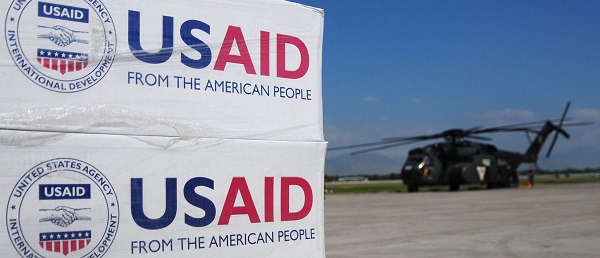MacDonald Laurier Institute
Canada, it’s not racist or xenophobic to talk about immigration

From the MacDonald Laurier Institute
By Joe Adam George
The sustained public antics post-October 7 has caused otherwise pro-immigrant Canadians to question the viability of our current policy
Since 1971, when Prime Minister Pierre Trudeau officially adopted a policy of multiculturalism, Canada has enthusiastically promoted and celebrated cultural diversity as a fundamental element of our national identity.
Perhaps wanting to step out of his father’s shadow and create his own legacy, in 2015, Prime Minister Justin Trudeau upped the multicultural ante by several notches, declaring to the world that Canada would become the “first post-national state”. In a now-infamous interview Trudeau claimed “there is no core identity, no mainstream in Canada.”
Last year, his government announced plans to welcome 500,000 new immigrants per year by 2025 and maintain those numbers annually in the subsequent years. Amidst growing public opposition to high immigration levels, Statistics Canada reported last month that Canada’s population grew by more than 430,000 during the third quarter of 2023 alone, marking the fastest pace of population growth since 1957 and pushing the country’s population past 40.5 million.
PM Trudeau’s pursuit of a post-national vision for Canada – through a blend of substantial hikes in immigration and a systemic push of woke progressivism that has effectively revised and erased Canadian history – has come at a significant cost to Canada’s national unity and security.
Examples of this disunity and lack of social integration have been particularly apparent in recent months. Following Hamas’ October 7 attacks against innocent Israeli civilians, the Jewish community in Canada have been subject to incessant acts of malice and violence by pro-Palestine protestors. Over the last three months, these dissenters have become a nuisance and a threat to all Canadians – from blocking traffic at major intersections and disrupting Christmas celebration events to intimidating businesses and shoppers, and in some extremely worrying instances, plotting to carry out terror attacks on Canadian soil.
Raging antisemitic and anti-Western speeches by controversial Muslim imams like Adil Charkaoui and Sheikh Younus Kathrada have added fuel to the fire (Charkaoui served jail time in 2003 on charges of terrorism and was later allowed a pathway to Canadian citizenship by a judge).
Predictably, questions about uncontrolled immigration and limited social integration have gained considerable prominence in the public square, so much so that the once-taboo topic of immigration could become a hot-button issue in the next federal election. The immigration discourse was already gaining traction on account of joint economic woes and the housing crisis, but the sustained public antics post-October 7 has caused otherwise pro-immigrant Canadians to question the viability of our current policy.
Eric Kaufmann, professor of politics at the University of Buckingham and Senior Fellow at the Macdonald-Laurier Institute, said to me in an interview, “A lot of the talk about integration misses the mark because it only takes into account integration indicators like people getting jobs, learning the language, voting, participating economically and politically, and even feeling a certain attachment to their adopted country, all of which I think are going reasonably well. The main driver for integration problems that we are currently seeing in Western countries is the degree of ethnocultural shifting that is taking place on account of mass immigration. This is bringing a much greater diversity of ethnic identities and religions and results in the importation of overseas conflicts into Western societies leading to inter-communal clashes between groups such as Sikh-Hindu, Muslim-Hindu or Muslim-Jew. The other factor is Islam and its perceived incompatibility with Western culture and values. All this contributes to the rise of populist movements across the globe, particularly in Europe.” Last month, an Angus Reid poll found that more than two-in-five (43%) Canadians believe Islam to be a “harmful presence” to their country.
Out of the over 1.3 million new immigrants who permanently settled in Canada from 2016 to 2021, approximately 1.14 million of them belonged to racialized communities, with most of them coming from South Asian, African and Arab countries. In a 2018 paper, Kaufmann and Matthew Goodwin argue that white Canadians will be a minority around the year 2050. It must be pointed out that this discussion is not about any deranged notion of preserving racial purity but about the effect of quick and massive ethnocultural change. Even with some mixing between cultures, geographic, marital and social patterns remain highly structured by ethnic identity in Canada; this is as true of the majority as of minorities, with white movers avoiding more diverse locations such as Richmond, BC or Brampton, ON. This attachment to one’s own group has been proven in the scholarly literature to be independent of any dislike of outgroups (except at times of violent conflict). Yet any mention of a sense of loss in the disruption of a previously dominant culture is immediately taken as hostility to outgroups and thus racist – a dishonest assessment.
Other countries that have traditionally welcomed a significant number of immigrants are now admitting that their immigration levels are out of control. Leaders (often privately) recognize that while linking immigration to job market needs, infrastructure capacity and economic growth opportunities is vital, greater value ought to be attached to encouraging immigrants to integrate and contribute to advancing a shared national vision. With elections looming in some of these countries, governments are taking belated measures to reduce the overall intake to appease their electorates.
The Danish government has advocated for a “zero refugee” policy. Australia announced new policies that are expected to cut down immigration by 50%. The UK Parliament passed a bill – dubbed “the toughest ever anti-illegal immigration legislation” – which aims to send illegal asylum-seekers to Rwanda. Germany approved legislation that would make it easier for authorities to quickly deport rejected asylum seekers. U.S. lawmakers are negotiating a deal to enforce security along its southern border with Mexico to combat illegal crossings.
It is worth highlighting that Denmark, Australia and Germany are run by left-wing or centre-left governments; mass immigration and social integration can be issues of concern to parties of all political stripes and not limited to “racist right-wing bigots” and “conservatives” as some might lazily portray. When asked which country Canada could take inspiration from to improve immigration controls, Kaufmann mentioned the Social Democrats in Denmark as exemplary.
“I think lowering numbers is absolutely at the heart of any successful immigration policy. I don’t think you can have high [immigration] numbers and not have a problem and you may even have different kinds of problems like antisemitism or anti-LGBTQ sentiments or communal conflicts or radicalization. Essentially, my view is that with high numbers and rapid cultural change, you simply get a loss of social connectedness. You have people in their bubbles moving around and that’s fine but when you get two groups that have an issue with each other, then you’re going to either have a conflict or you tend to get less civic-minded”, he said, citing renowned American political scientist, Robert Putnam’s thesis ‘E Pluribus Unum: Diversity and Community in the Twenty-first Century’. Putnam contends that sharp increases in immigration and ethnic diversity tend to reduce social solidarity and social capital in the short run, meaning social trust (even of one’s own race) would be lower, altruism and community cooperation rarer, and friends fewer, although on the flipside, it is likely to have long-term cultural, economic, fiscal, and developmental benefits.
When asked what continued mass immigration could mean for Canada, Kaufmann said, “I think Canada is moving in the direction of being a low-cohesion society. I mean, if that’s the choice they want to make, that’s fine. I think it’s partly because political correctness is stronger in Canada than almost anywhere else. So, it’s impossible to really have an honest debate about immigration which is one reason why the numbers are so high in Canada compared to other countries. It’s about what the elites will allow you to talk about in a democracy without labeling you a racist, which is completely dishonest, but that’s the way the debate has been conducted in Canada, as some sort of a sacred cow. It’s less sacred in Europe and so there’s more of a real debate around immigration numbers.”
Last month, fueled by concerns over growing antisemitism, the German state of Saxony-Anhalt made it mandatory for applicants wishing to live in the state to recognize Israel’s right to exist. In 2006, the Netherlands made it compulsory for prospective immigrants to watch a film with images of gay men kissing or topless women as part of the civic integration exam to test their readiness to participate in the Dutch liberal society.
When asked if such a values-based test or declaration for prospective immigrants was feasible, Kaufmann said, “People are allowed to have different opinions, even if they may be obnoxious. Even within the citizenry, there are people who don’t recognize the state of Israel and that’s an opinion you’re allowed to have. I think the test should probably focus on subjects like toleration of gays, Jews and women. However, I don’t think Canada is willing to consider qualitative culture-based criteria, such as assimilability to Canadian values, to assess potential immigrants, like they currently do in countries like Denmark, even though I think it would be a good idea. Canadian immigration is completely rooted in voodoo-based reasoning and there’s no economic or demographic rationale to it. The idea that immigration is a sustainable solution to the aging problem, for instance, has been comprehensively debunked. Somehow, it is a religion amongst Canadian elites and to some degree, across political parties. The Conservatives are too scared to touch it out of fear of being branded as racist and anti-immigrant by other parties and the media, even though most of their voters want a lot lower numbers. Regardless, you’ve got a cross-party consensus which is not based in reality.”
In 2016, federal Conservative leadership hopeful Kellie Leitch was heavily criticized, even by members of her own party, for floating the idea of screening out would-be immigrants to Canada, if they were openly intolerant or did not accept Canadian values and traditions such as respect and tolerance for other cultures, freedom of speech and equality.
The systematic dismantling and belittling of Canada’s history by our governments and institutions has left many immigrants seeing very little worth embracing in Canada, often resulting in a retention of their original values– some of which are contradictory to Canadian values and pose a hazard to the safety and security of vulnerable groups like LGBTQ, Jews, women and children.
While Kaufmann does not think Trudeau’s post-national comments have had an impact on the ground on their own, he said they reflect the mindset of the cultural left-dominated or progressive-dominated society.
“The media and the political culture in Canada are dominated by progressivism on any cultural issues, whether that be LGBTQ, religion, ethnicity or immigration. The longstanding narrative in Canadian academia about Canadian identity is that Canada’s just a multicultural country and the only thing it stands for is tolerance and diversity. In a way, multiculturalism is, more or less, a restatement of a post-national country that doesn’t really have a national identity and that’s what the elites want. It is a national identity that claims to have the moral high ground by proclaiming we don’t care about ethnicity or culture because we’re so virtuous and that is really what Trudeau implied. This is still a kind of national identity but based on pride in being holier than thou. His comments reflect an elitist philosophy that has led to record levels of immigration and poor integration.”
The Israel-Hamas war has highlighted the failure of integration inevitably resulting from rapid and uncontrolled mass immigration. Scenes of protestors disrupting Black Friday shopping and Christmas celebrations, or even threatening to kill people in the presence of police officers, were unimaginable in Canada not long ago.
First or second-generation immigrants like me – whether they be permanent residents, students, illegal aliens, or citizens – have immensely benefitted from the magnanimity of Western countries like Canada. In many cases we were offered refuge from the hatred, tyranny, racism, sexism, terrorism, and violence of our home countries. It should not be considered controversial or racist to point out instances of fellow immigrants treating Western generosity and tolerance as weaknesses to be manipulated, bragging about their growing numbers and the political clout they have amassed in liberal democracies (apparently without awareness of the hypocrisy apparent in their support for illiberal tyrannies whose violence drove them to take refuge in the West in the first place). Aaron Wudrick, Director of Domestic Policy at the Macdonald-Laurier Institute, encapsulates this view accurately in his tweet: “The important question isn’t how Canadians identify in terms of ethnicity. It’s whether they identify as *Canadian* and feel any attachment, belonging or commitment to our shared institutions.”
It is dishonest and irrational to label everyone concerned about out-of-control immigration numbers and the need for social cohesion as racist or xenophobic. The sooner we rid ourselves of fallacious name calling, the sooner we can start a serious debate about the best way forward for a compassionate and sustainable immigration policy that prioritizes Canada’s long-term national unity, security and economic interests.
Joe Adam George is a former foreign policy and national security research intern with the Washington, D.C.-based policy think tank, Hudson Institute, and a communications strategist.
Alberta
‘Far too serious for such uninformed, careless journalism’: Complaint filed against Globe and Mail article challenging Alberta’s gender surgery law

Macdonald Laurier Institute challenges Globe article on gender medicine
The complaint, now endorsed by 41 physicians, was filed in response to an article about Alberta’s law restricting gender surgery and hormones for minors.
On June 9, the Macdonald-Laurier Institute submitted a formal complaint to The Globe and Mail regarding its May 29 Morning Update by Danielle Groen, which reported on the Canadian Medical Association’s legal challenge to Alberta’s Bill 26.
Written by MLI Senior Fellow Mia Hughes and signed by 34 Canadian medical professionals at the time of submission to the Globe, the complaint stated that the Morning Update was misleading, ideologically slanted, and in violation the Globe’s own editorial standards of accuracy, fairness, and balance. It objected to the article’s repetition of discredited claims—that puberty blockers are reversible, that they “buy time to think,” and that denying access could lead to suicide—all assertions that have been thoroughly debunked in recent years.
Given the article’s reliance on the World Professional Association for Transgender Health (WPATH), the complaint detailed the collapse of WPATH’s credibility, citing unsealed discovery documents from an Alabama court case and the Cass Review’s conclusion that WPATH’s guidelines—and those based on them—lack developmental rigour. It also noted the newsletter’s failure to mention the growing international shift away from paediatric medical transition in countries such as the UK, Sweden, and Finland. MLI called for the article to be corrected and urged the Globe to uphold its commitment to balanced, evidence-based journalism on this critical issue.
On June 18, Globe and Mail Standards Editor Sandra Martin responded, defending the article as a brief summary that provided a variety of links to offer further context. However, the three Globe and Mail news stories linked to in the article likewise lacked the necessary balance and context. Martin also pointed to a Canadian Paediatric Society (CPS) statement linked to in the newsletter. She argued it provided “sufficient context and qualification”—despite the fact that the CPS itself relies on WPATH’s discredited guidelines. Notwithstanding, Martin claimed the article met editorial standards and that brevity justified the lack of balance.
MLI responded that brevity does not excuse misinformation, particularly on a matter as serious as paediatric medical care, and reiterated the need for the Globe to address the scientific inaccuracies directly. MLI again called for the article to be corrected and for the unsupported suicide claim to be removed. As of this writing, the Globe has not responded.
Letter of complaint
June 9, 2025
To: The Globe and Mail
Attn: Sandra Martin, standards editor
CC: Caroline Alphonso, health editor; Mark Iype, deputy national editor and Alberta bureau chief
To the editors;
Your May 29 Morning Update: The Politics of Care by Danielle Groen, covering the Canadian Medical Association’s legal challenge to Alberta’s Bill 26, was misleading and ideologically slanted. It is journalistically irresponsible to report on contested medical claims as undisputed fact.
This issue is far too serious for such uninformed, careless journalism lacking vital perspectives and scientific context. At stake is the health and future of vulnerable children, and your reporting risks misleading parents into consenting to irreversible interventions based on misinformation.
According to The Globe and Mail’s own Journalistic Principles outlined in its Editorial Code of Conduct, the credibility of your reporting rests on “solid research, clear, intelligent writing, and maintaining a reputation for honesty, accuracy, fairness, balance and transparency.” Moreover, your principles go on to state that The Globe will “seek to provide reasonable accounts of competing views in any controversy.” The May 29 update violated these principles. There is, as I will show, a widely available body of scientific information that directly contests the claims and perspectives presented in your article. Yet this information is completely absent from your reporting.
The collapse of WPATH’s credibility
The article’s claim that Alberta’s law “falls well outside established medical practice” and could pose the “greatest threat” to transgender youth is both false and inflammatory. There is no global medical consensus on how to treat gender-distressed young people. In fact, in North America, guidelines are based on the Standards of Care developed by the World Professional Association for Transgender Health (WPATH)—an organization now indisputably shown to place ideology above evidence.
For example, in a U.S. legal case over Alabama’s youth transition ban, WPATH was forced to disclose over two million internal emails. These revealed the organization commissioned independent evidence reviews for its latest Standards of Care (SOC8)—then suppressed those reviews when they found overwhelmingly low-quality evidence. Yet WPATH proceeded to publish the SOC8 as if it were evidence-based. This is not science. It is fraudulent and unethical conduct.
These emails also showed Admiral Rachel Levine—then-assistant secretary for Health in the Biden administration—pressured WPATH to remove all lower age recommendations from the guidelines—not on scientific grounds, but to avoid undermining ongoing legal cases at the state level. This is politics, not sound medical practice.
The U.K.’s Cass Review, a major multi-year investigation, included a systematic review of the guidelines in gender medicine. A systematic review is considered the gold standard because it assesses and synthesizes all the available research in a field, thereby reducing bias and providing a large comprehensive set of data upon which to reach findings. The systematic review of gender medicine guidelines concluded that WPATH’s standards of care “lack developmental rigour” and should not be used as a basis for clinical practice. The Cass Review also exposed citation laundering where medical associations endlessly recycled weak evidence across interlocking guidelines to fabricate a false consensus. This led Cass to suggest that “the circularity of this approach may explain why there has been an apparent consensus on key areas of practice despite the evidence being poor.”
Countries like Sweden, Finland, and the U.K. have now abandoned WPATH and limited or halted medicalized youth transitions in favour of a therapy-first approach. In Norway, UKOM, an independent government health agency, has made similar recommendations. This shows the direction of global practice is moving away from WPATH’s medicalized approach—not toward it. As part of any serious effort to “provide reasonable accounts of competing views,” your reporting should acknowledge these developments.
Any journalist who cites WPATH as a credible authority on paediatric gender medicine—especially in the absence of contextualizing or competing views—signals a lack of due diligence and a fundamental misunderstanding of the field. It demonstrates that either no independent research was undertaken, or it was ignored despite your editorial standards.
Puberty blockers don’t ‘buy time’ and are not reversible
Your article repeats a widely debunked claim: that puberty blockers are a harmless pause to allow young people time to explore their identity. In fact, studies have consistently shown that between 98 per cent and 100 per cent of children placed on puberty blockers go on to take cross-sex hormones. Before puberty blockers, most children desisted and reconciled with their birth sex during or after puberty. Now, virtually none do.
This strongly suggests that blocking puberty in fact prevents the natural resolution of gender distress. Therefore, the most accurate and up-to-date understanding is that puberty blockers function not as a pause, but as the first step in a treatment continuum involving irreversible cross-sex hormones. Indeed, a 2022 paper found that while puberty suppression had been “justified by claims that it was reversible … these claims are increasingly implausible.” Again, adherence to the Globe’s own editorial guidelines would require, at minimum, the acknowledgement of the above findings alongside the claims your May 29 article makes.
Moreover, it is categorically false to describe puberty blockers as “completely reversible.” Besides locking youth into a pathway of further medicalization, puberty blockers pose serious physical risks: loss of bone density, impaired sexual development, stunted fertility, and psychosocial harm from being developmentally out of sync with peers. There are no long-term safety studies. These drugs are being prescribed to children despite glaring gaps in our understanding of their long-term effects.
Given the Globe’s stated editorial commitment to principles such as “accuracy,” the crucial information from the studies linked above should be provided in any article discussing puberty blockers. At a bare minimum, in adherence to the Globe’s commitment to “balance,” this information should be included alongside the contentious and disputed claims the article makes that these treatments are reversible.
No proof of suicide prevention
The most irresponsible and dangerous claim in your article is that denying access to puberty blockers could lead to “depression, self-harm and suicide.” There is no robust evidence supporting this transition-or-suicide narrative, and in fact, the findings of the highest-quality study conducted to date found no evidence that puberty suppression reduces suicide risk.
Suicide is complex and attributing it to a single cause is not only false—it violates all established suicide reporting guidelines. Sensationalized claims like this risk creating contagion effects and fuelling panic. In the public interest, reporting on the topic of suicide must be held to the most rigorous standards, and provide the most high-quality and accurate information.
Euphemism hides medical harm
Your use of euphemistic language obscures the extreme nature of the medical interventions being performed in gender clinics. Calling double mastectomies for teenage girls “paediatric breast surgeries for gender-affirming reasons” sanitizes the medically unnecessary removal of a child’s healthy organs. Referring to phalloplasty and vaginoplasty as “gender-affirming surgeries on lower body parts” conceals the fact that these are extreme operations involving permanent disfigurement, high complication rates, and often requiring multiple revisions.
Honest journalism should not hide these facts behind comforting language. Your reporting denies youth, their parents, and the general public the necessary information to understand the nature of these interventions. Members of the general public rely greatly on the news media to equip them with such information, and your own editorial standards claim you will fulfill this core responsibility.
Your responsibility to the public
As a flagship Canadian news outlet, your responsibility is not to amplify activist messaging, but to report the truth with integrity. On a subject as medically and ethically fraught as paediatric gender medicine, accuracy is not optional. The public depends on you to scrutinize claims, not echo ideology. Parents may make irreversible decisions on behalf of their children based on the narratives you promote. When reporting is false or ideologically distorted, the cost is measured in real-world harm to some of our society’s most vulnerable young people.
I encourage the Globe and Mail to publish an updated version on this article in order to correct the public record with the relevant information discussed above, and to modify your reporting practices on this matter going forward—by meeting your own journalistic standards—so that the public receives balanced, correct, and reliable information on this vital topic.
Trustworthy journalism is a cornerstone of public health—and on the issue of paediatric gender medicine, the stakes could not be higher.
Sincerely,
Mia Hughes
Senior Fellow, Macdonald-Laurier Institute
Author of The WPATH Files
The following 41 physicians have signed to endorse this letter:
Dr. Mike Ackermann, MD
Dr. Duncan Veasey, Psy MD
Dr. Rick Gibson, MD
Dr. Benjamin Turner, MD, FRCSC
Dr. J.N. Mahy, MD, FRCSC, FACS
Dr. Khai T. Phan, MD, CCFP
Dr. Martha Fulford, MD
Dr. J. Edward Les, MD, FRCPC
Dr. Darrell Palmer, MD, FRCPC
Dr. Jane Cassie, MD, FRCPC
Dr. David Lowen, MD, FCFP
Dr. Shawn Whatley, MD, FCFP (EM)
Dr. David Zitner, MD
Dr. Leonora Regenstreif, MD, CCFP(AM), FCFP
Dr. Gregory Chan, MD
Dr. Alanna Fitzpatrick, MD, FRCSC
Dr. Chris Millburn, MD, CCFP
Dr. Julie Curwin, MD, FRCPC
Dr. Roy Eappen, MD, MDCM, FRCP (c)
Dr. York N. Hsiang, MD, FRCSC
Dr. Dion Davidson, MD, FRCSC, FACS
Dr. Kevin Sclater, MD, CCFP (PC)
Dr. Theresa Szezepaniak, MB, ChB, DRCOG
Dr. Sofia Bayfield, MD, CCFP
Dr. Elizabeth Henry, MD, CCFP
Dr. Stephen Malthouse, MD
Dr. Darrell Hamm, MD, CCFP
Dr. Dale Classen, MD, FRCSC
Dr. Adam T. Gorner, MD, CCFP
Dr. Wesley B. Steed, MD
Dr. Timothy Ehmann, MD, FRCPC
Dr. Ryan Torrie, MD
Dr. Zachary Heinricks, MD, CCFP
Dr. Jessica Shintani, MD, CCFP
Dr. Mark D’Souza, MD, CCFP(EM), FCFP*
Dr. Joanne Sinai, MD, FRCPC*
Dr. Jane Batt, MD*
Dr. Brent McGrath, MD, FRCPC*
Dr. Leslie MacMillan MD FRCPC (emeritus)*
Dr. Ian Mitchell, MD, FRCPC*
Dr. John Cunnington, MD
*Indicates physician who signed following the letter’s June 9 submission to the Globe and Mail, but in advance of this letter being published on the MLI website.
Alberta
High costs, low returns – Canada’s wildly expensive emissions cap
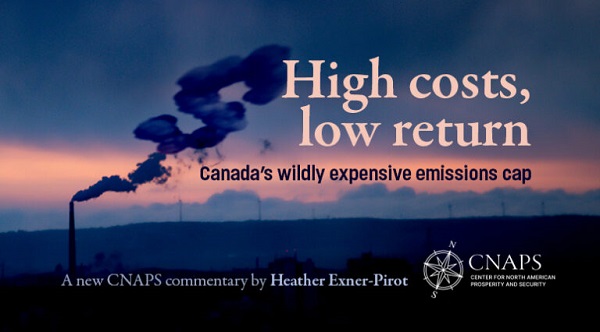
In this new commentary, Director of Energy, Natural Resources, and Environment Heather Exner-Pirot reveals why the Canadian government’s oil and gas emissions cap isn’t just expensive – it’s economic insanity.
Canada is the world’s third-largest exporter of oil, fourth-largest producer, and top source of imports to the United States. Much of Canada’s oil wealth is concentrated in the oil sands in northern Alberta, which hosts 99 percent of the country’s enormous oil endowment: about 160 billion barrels of proven reserves, of a total resource of approximately 1.8 trillion barrels. This is the major source of oil to the United States refinery complex, a large part of which is optimized for the oil sands’ heavy oil.
Reliability of energy supply has remerged as a major geopolitical issue. Canadian oil and gas is an essential component of North American energy security. Yet a proposed cap on emissions from the sectors promises to cut Canadian production and exports in the years ahead. It would be hard to provide less environmental benefit for a higher economic and security cost. There are far better ways to reduce emissions while maintaining North America’s security of energy supply.
The high cost of the cap
In 1994 a Liberal federal government, Alberta provincial conservative government and representatives from the oil and gas industry, working together through the national oil sands task force, developed A New Energy Vision for Canada. Their efforts turned what was then a middling resource into a trillion dollar nation-building project. Production has increased tenfold since the report came out.
The task force acknowledged the need for industry to “put its best efforts toward … reducing greenhouse gas emissions.” However, it also expected governments to “understand” that there “is no benefit to Canada or to the environment to have production and value-added processing done outside of the country in less efficient jurisdictions … policies set by regulator must not result in discouraging oil sands production.”
As part of its efforts to meet its climate goals under the Paris Accord, the Canadian government proposed a regulatory framework for an emissions cap on the oil and gas sector in December 2023. It set a legally binding limit on greenhouse gas emissions, targeting a 35 to 38 percent reduction from 2019 levels by 2030 for upstream operations, through regulations to be made under the Canadian Environmental Protection Act, 1999 (CEPA).
The federal government has not yet finalized its proposed regulations. However, industry experts and economists have criticized the current iteration as logistically unworkable, overly expensive, and likely to be challenged as unconstitutional. In effect, this policy layers a cap-and-trade system for just one sector (oil and gas) on top of a competing carbon pricing mechanism (the large-emitter trading systems, often referred to as the industrial carbon price), a discriminatory practice that also undermines the entire economic rationale of a carbon pricing system.
While the Canadian government has maintained that it is focused on reducing emissions rather than production – the latter of which would put it at odds with provincial jurisdiction over non-renewable resources – a series of third party analyses as well as the Parliamentary Budget Office’s own impact assessment find it would indeed constrain Canadian oil and gas production. The economic cost of the emissions cap far exceeds any corresponding benefit in reduced emissions.
How much will the emissions cap cost in terms of dollar per tonne of carbon in avoided emissions, both domestically and globally? Based solely on the cost to the Canadian economy, we estimate the emission cap is equivalent to a C$2,887/tonne carbon price by 2032.
Assuming no impact on global demand and full substitution by non-Canadian crudes, it finds that the cost of each tonne of carbon displaced globally is between C$96,000 to C$289,000 for oil sands bitumen production. For displaced Canadian conventional and natural gas, the cost is infinite, i.e. global emissions would actually be higher for every barrel or unit of Canadian oil and gas displaced with competitor products as a result of the emissions cap.
Canadian oil and gas emissions reduction efforts
The oil and gas sector is the highest emitting economic sector in Canada. However, it has made substantial efforts to reduce emissions over the past two decades and is succeeding. Absolute emissions in the sector peaked in 2014, despite production growing by over a million barrels of oil equivalent since (see Figure 1).
 Figure 1 Indexed greenhouse gas (GHG) emissions (and gross domestic product (GDP) at basic prices, for the oil and gas extraction industry, 2009 to 2022 (2009 = 100). Source: Statistics Canada 2024.
Figure 1 Indexed greenhouse gas (GHG) emissions (and gross domestic product (GDP) at basic prices, for the oil and gas extraction industry, 2009 to 2022 (2009 = 100). Source: Statistics Canada 2024.
Much of this success can be attributed to methane capture, particularly in the natural gas and conventional oil sectors, where absolute emissions peaked in 2007 and 2014 respectively.
Since 2014, the oil sands have dramatically increased production by over a million barrels per day, but at the same time have reduced the emissions per barrel every year, leaving the absolute emissions of the oil and gas sector relatively flat. The oil sands are performing well vis-à-vis their international peers, seeing their emissions per barrel decline by 30 percent since 2013, compared to 21 percent for global majors and 34 percent for US E&Ps (exploration and production companies) (see Figure 2).
 Figure 2 Indexed Oil Sands GHG relative intensity trend (2013=100). Source: BMO Capital Markets, “I Want What You Got: Canada’s Oil Resource Advantage,” April 2025
Figure 2 Indexed Oil Sands GHG relative intensity trend (2013=100). Source: BMO Capital Markets, “I Want What You Got: Canada’s Oil Resource Advantage,” April 2025
On an emissions intensity absolute basis, the oil sands have significantly outperformed their peers, shaving off 25kg/barrel of emissions since 2013 (see Figure 3) and more than 65kg/barrel since the oil sands task force wrote their report in 1994.
As emissions improvements from methane reductions plateau, the oil sands are likely to outperform their conventional peers in emissions per barrel reductions going forward. The sector is working on strategies such as solvent extraction and carbon capture and storage that, if implemented, would reduce the life-cycle emissions per barrel of oil sands to levels at or below the global crude average.
 Figure 3 Emissions intensity absolute change (kg CO2e/bbl) (2013–24E) Source: BMO Capital Markets, 2025
Figure 3 Emissions intensity absolute change (kg CO2e/bbl) (2013–24E) Source: BMO Capital Markets, 2025
The high cost of the cap
Several parties have analyzed the proposed emissions cap to determine its economic and production impact. The results of the assessments vary widely. For the purposes of this commentary we rely on the federal Office of the Parliamentary Budget Officer (PBO), which published its analysis of the proposed emissions cap in March 2025. Helpfully, the PBO provided a table summarizing the main findings of the various analyses (see Table 1).
The PBO found that the required reduction in upstream oil and gas sector production levels under an emissions cap would lower real gross domestic product (GDP) in Canada by 0.33 percent in 2030 and 0.39 percent in 2032, and reduce nominal GDP by C$20.5 billion by 2032. The PBO further estimated that achieving the legal upper bound would reduce economy-wide employment in Canada by 40,300 jobs and full-time equivalents by 54,400 in 2032.
 Table 2 Comparison of estimated impacts of the proposed emissions cap in 2030. Source: PBO 2025
Table 2 Comparison of estimated impacts of the proposed emissions cap in 2030. Source: PBO 2025
However, the PBO does not estimate the carbon price per tonne of emissions reduced. This is a useful metric as Canadians have become broadly familiar with the real-world impacts of a price on carbon. The federal government quashed the consumer carbon price at $80/tonne in March 2025, ahead of the federal election, due to its unpopularity and perceived impacts on affordability. The federal carbon pricing benchmark is scheduled to hit C$170 in 2030. ECCC has quantified the damages of a tonne of carbon dioxide – referred to as the “Social Cost of Carbon” – as C$294/tonne.
Based on PBO assumptions that the emissions cap will reduce emissions by 7.1MT and reduce GDP by $20.5 billion in 2032, the implied carbon price is C$2,887/tonne.
Emissions cap impact in a global context
Even this eye-popping figure does not tell the full story. The Canadian oil and gas production that must be withdrawn to meet the requirements of the emissions cap will be replaced in global markets from other producers; there is no reason to assume the emissions cap will affect global demand.
Based on life-cycle GHG emissions of the sample of crudes used in the US refinery complex, Canadian oil sands produce only 1 to 3 percent higher emissions than a global average[1] (see Figure 4), with some facilities producing lower emissions than the average barrel.
 Figure 4 Life Cycle GHG emissions of crude oils (kg CO2e/bbl). Source: BMO Capital Markets 2025
Figure 4 Life Cycle GHG emissions of crude oils (kg CO2e/bbl). Source: BMO Capital Markets 2025
As such, the emissions cap, if applied just to oil sands production, would only displace global emissions of 71,000 to 213,000 tonnes (1 to 3 percent of 7.1MT). At a cost of C$20.5 billion for those global emissions reductions, the price of carbon is equivalent to C$96,000 to C$289,000 per tonne (see Figure 5).
 Figure 5 Cost per tonne of emissions cap behind domestic carbon all (left) and post-global crude substitution (right)
Figure 5 Cost per tonne of emissions cap behind domestic carbon all (left) and post-global crude substitution (right)
For any displaced conventional Canadian crude oil or natural gas, the situation becomes absurd. Because Canadian conventional oil and natural gas have a lower emissions intensity than global averages, global product substitutions resulting from the emissions cap would actually serve to increase global emissions, resulting in an infinite price per tonne of carbon.
The C$100k/tonne carbon price estimate is probably low
We believe our assessment of the effective carbon price of the emissions cap at C$96,000+/tonne to be conservative for the following reasons.
First, it assumes Canadian heavy oil will be displaced in global markets by an average, archetypal crude. In fact, it would be displaced by other heavy crudes from places like Venezuela, Mexico, and Iraq (see Figure 4), which have higher average emissions per barrel than Canadian oil sands crudes. In such a circumstance, global emissions would actually rise and the price per carbon tonne from an emissions cap on oil sands production would also effectively be infinite.
Secondly, emissions cap impact assumptions by the PBO are likely conservative. Those by ECCC, based on a particular scenario outlook, are already outdated. ECCC assumed a production loss of only 0.7 percent by 2030, with oil sands production hitting approximately 3.7 million barrels (MMbbls) per day of bitumen production in 2030. According to S&P Global analysis, that level is likely to be hit this year.[2]
S&P further forecasts oil sands production to reach 4.0 MMbbls by 2030, or about 300,000 barrels more than it produces today. This would represent a far lower production growth rate than the oil sands have experienced in the past five years. But assuming the S&P forecast is correct, production would need to decline in the oil sands by 8 percent to meet the emissions cap requirements. PBO assumed only a 5.4 percent overall oil and gas production loss and ECCC assumed only 0.7 percent, while Conference Board of Canada assumed an 11.1 percent loss and Deloitte assumed 11.5 percent (see Table 1). Production numbers to date more closely align with Conference Board of Canada and Deloitte projections.
Let’s make the Canadian oil and gas sector better, not smaller
The Canadian oil and gas sector, and in particular the oil sands, has a responsibility to do their part to reduce emissions while maintaining competitive businesses that can support good Canadian jobs, provide government revenues and diversify exports. The oil sands sector has re-invested for decades in continuous improvements to drive down production costs while improving its emissions per barrel.
It is hard to conceive of a more expensive and divisive way to reduce emissions from the sector and from the Canadian economy than the proposed emissions cap. Other expensive programs, such as Norway’s EV subsidies, the United Kingdom’s offshore wind contracts-for-difference, Germany’s Energiewende feed-in-tariffs and surcharges, and US Inflation Reduction Act investment tax credits, don’t come close to the high costs of the emissions cap on a price-per-tonne of carbon abated basis.
The emissions cap, as currently proposed, will make Canada’s oil and gas sector significantly less competitive, harm investment, and undermine Canada’s vision to be an energy superpower. This policy will also reduce the oil and gas sector’s capacity to invest in technologies that drive additional emission reductions, such as solvents and carbon capture, especially in our current lower price environment. As such it is more likely to undermine climate action than support it.
The federal and provincial governments have come together to advance a vision for Canadian energy in the past. In this moment, they have the opportunity once again to find real solutions to the climate challenge while harnessing the energy sector to advance Canada’s economic well-being, productivity, and global energy security.
About the author
Heather Exner-Pirot is Director of Energy, Natural Resources, and Environment at the Macdonald-Laurier Institute.
-
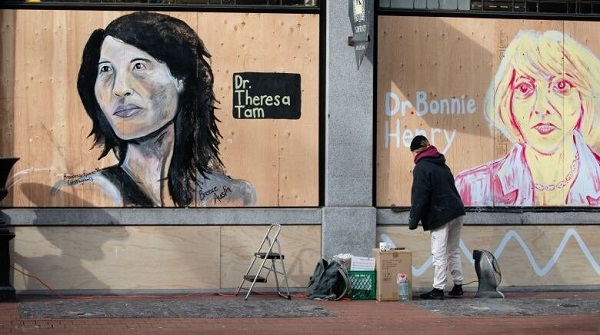
 Bruce Dowbiggin2 days ago
Bruce Dowbiggin2 days agoThe Covid 19 Disaster: When Do We Get The Apologies?
-
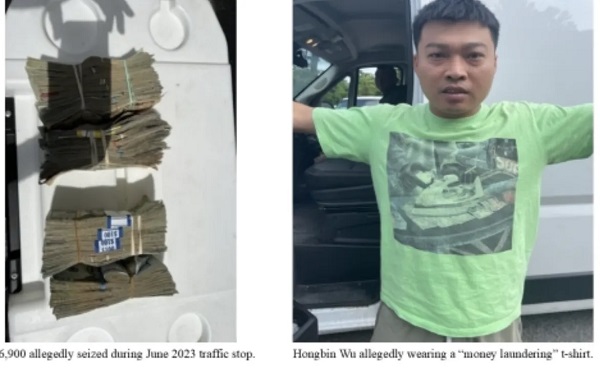
 Crime1 day ago
Crime1 day agoSweeping Boston Indictment Points to Vast Chinese Narco-Smuggling and Illegal Alien Labor Plot via Mexican Border
-
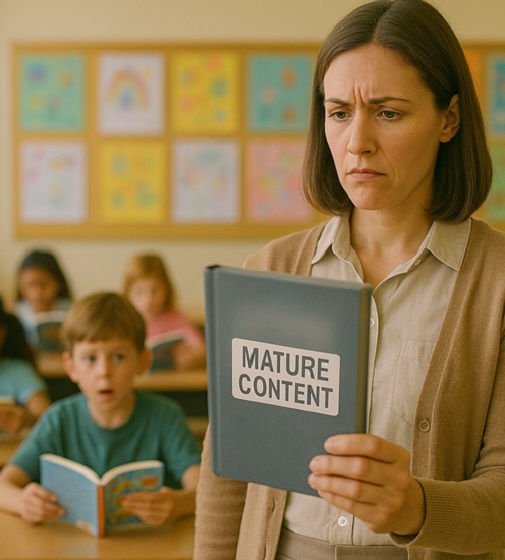
 Alberta2 days ago
Alberta2 days agoAlberta school boards required to meet new standards for school library materials with regard to sexual content
-
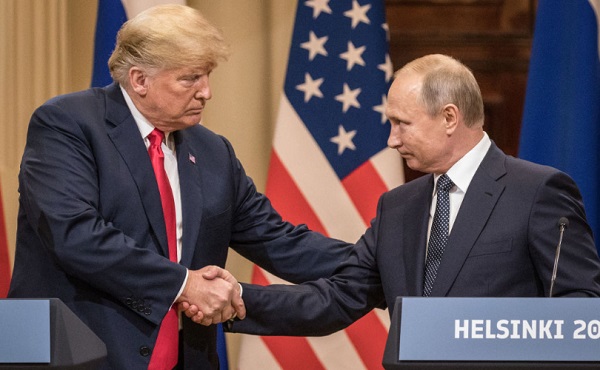
 International20 hours ago
International20 hours agoSupport for the Ukraine war continues because no one elected is actually in charge.
-
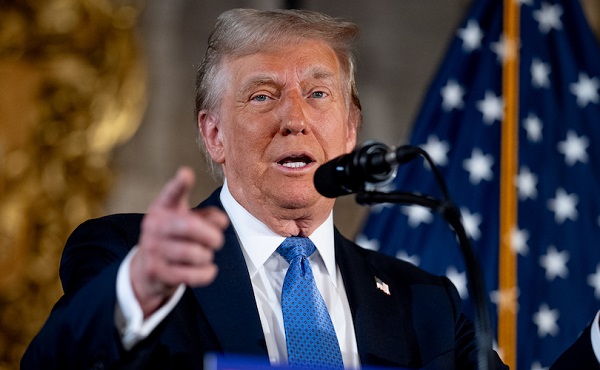
 Business20 hours ago
Business20 hours agoTrump slaps Brazil with tariffs over social media censorship
-

 Environment1 day ago
Environment1 day agoEPA releases report on chemtrails, climate manipulation
-
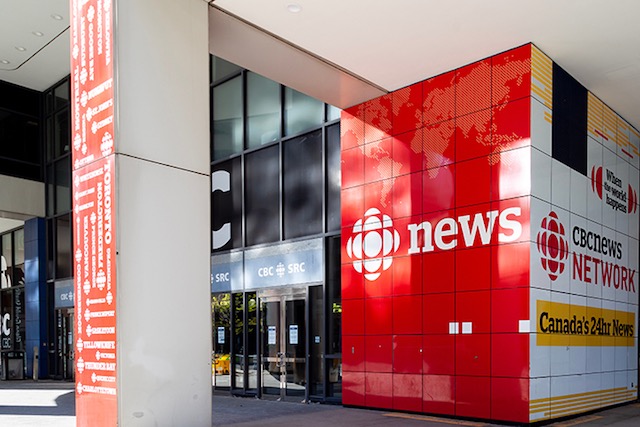
 Business23 hours ago
Business23 hours agoCBC six-figure salaries soar
-

 Addictions22 hours ago
Addictions22 hours agoCan addiction be predicted—and prevented?



